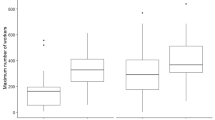Abstract
During reproduction, ant colonies produce winged queens. These new queens usually leave the nest to mate and can then establish a new nest. If the new nest is close to an existing colony, it will be in competition with the existing colony. Therefore, workers will kill any mated queens they find outside the colony during the reproductive season. In this study, factors that might determine whether workers eliminate queens were investigated. Mating status (mated or unmated), colony origin (same or different to tested workers) and mating partners (inbred or outbred) of the queens of Japanese harvester ants (Messor aciculatus) were manipulated and the workers’ behavior towards the queens was observed. Mated queens were always attacked by workers, though this was not affected by either colony origin or mating partners. These results suggest that mating status triggers elimination of queens by workers, and that the colony origin and mating partner are unlikely to be important roles in elimination of queens.


Similar content being viewed by others
References
Andersen AN (1991) Parallels between ants and plants: implications for community ecology. In: Huxley CR, Cutler DF (eds) Ant-plant interactions. Oxford University Press, Oxford, pp 539–558
Brown JH, Davidson DW (1977) Competition between seed-eating rodents and ants in desert ecosystems. Science 196:880–882
Cerdá X, Arnan X, Retana J (2013) Is competition a significant hallmark of ant (Hymenoptera: Formicidae) ecology? Myrmecological News 18:131–147
Connell JH (1961) Effects of competition, predation by Thais lapillus and other factors on natural populations of the barnacle Balanus balanoides. Ecol Monogr 31:61–104
Dayton PK (1971) Competition, disturbance and community organization: the provision and subsequent utilization of space in a rocky intertidal community. Ecol Monogr 41:351–389
Fellers JH (1987) Interference and exploitation in a guild of woodland ants. Ecology 68:1466–1478
Folgarait PJ (1998) Ant biodiversity and its relationship to ecosystem functioning: a review. Biodivers Conserv 7:1221–1244
Gordon DM (1991) Behavioral flexibility and the foraging ecology of seed-eating ants. Am Nat 138:379–341
Gordon DM, Kulig AW (1996) Founding, foraging, and fighting: colony size and the spatial distribution of harvester ant nests. Ecology 77:2393–2409
Harrison JS, Gentry JB (1981) Foraging pattern, colony distribution, and foraging range of the Florida harvester ant, Pogonomyrmex badius. Ecology 62:1467–1473
Hölldobler B, Wilson EO (1990) The ants. Belknap Press of Harvard Universtiy Press, Cambridge
Johnson RA (2001) Biogeography and community structure of North American seed-harvester ants. Annu Rev Entomol 46:1–29
Keeler KH (1993) Fifteen years of colony dynamics in Pogonomyrmex occidentalis, the western harvester ant, in western Nebraska. Southwest Nat 38:286–289
Levings SC, Franks NR (1982) Patterns of nest dispersion in a tropical ground ant community. Ecology 63:338–344
Paine RT (1966) Food web complexity and species diversity. Am Nat 100:65–75
Pfennig DW (1995) Absence of joint nesting advantage in desert seed harvester ants - evidence from a field experiment. Anim Behav 49:567–575
Ryti RT, Case TJ (1984) Spatial arrangement and diet overlap between colonies of desert ants. Oecologia 62:401–404
Ryti RT, Case TJ (1988) Field experiments on desert ants: testing for competition between colonies. Ecology 69:1993–2003
Savolainen R, Vepsäläinen K (1988) A competition hierarchy among boreal ants: impact on resource partitioning and community structure. Oikos 51:135–155
Sturgis S, Gordon D (2012) Nestmate recognition in ants (Hymenoptera: Formicidae): a review. Myrmecological News 16:101–110
Terayama M, Kubota S, Eguchi K (2014) Encyclopedia of Japanese ants. Asakura Publishing Co.Ltd, Tokyo
Wiernasz DC, Cole BJ (1995) Spatial distribution of Pogonomyrmex occidentalis: recruitment, mortality and overdispersion. J Anim Ecol 64:519–527
Wiernasz DC, Cole BJ (2003) Queen size mediates queen survival and colony fitness in harvester ants. Evolution 57:2179–2183
Yamaguchi T (1995) Intraspecific competition through food robbing in the harvester ant, Messor aciculatus (Fr. Smith), and its consequences on colony survival. Insect Soc 42:89–101
Acknowledgements
We thank VAIC-CCI Yachimata centre for permitting us to collect ants. We are grateful to Michiko Fukumoto, Yuya Fukumoto and staff members of VAIC-CCI Yachimata centre for help collecting the queens. We thank two anonymous referees for their constructive comments.
Author information
Authors and Affiliations
Corresponding author
Rights and permissions
About this article
Cite this article
Takata, M., Thomas, C.E. & Koyama, S. Mating Triggers Queen Elimination by Workers of Japanese Harvester Ant (Messor aciculatus). J Insect Behav 31, 277–282 (2018). https://doi.org/10.1007/s10905-018-9678-9
Revised:
Accepted:
Published:
Issue Date:
DOI: https://doi.org/10.1007/s10905-018-9678-9




